


Payoff Quote [U0213]
Contents
Introduction
The
Payoff Quote update [U0213] is used to generate payoff or termination quotes for
a lease or an asset. It enables the user to store information for a quote or retrieve
the last saved quote for review. All information for the quote is saved, including
the initials of the person who requested it and the date/time of the quote. Certain
elements of the quote may be adjusted (e.g., fee/penalty charged), and 2 lines
of free-form comments may be entered and stored with the other quote information.
If a quote exists for
a lease or an asset at the time of the actual processing of a payoff or termination,
information from the quote may be recalled to use in processing the payoff/termination.
Data from the quote is displayed on the payoff/termination screen and may be modified
if desired.
When a Payoff/Termination
quote exists, the Payoff Quote update [U0213] will default the quote which has
the earliest effective date and the current date falls prior to the Good Until
date. If the date has expired or the effective date does not meet the current
effective date, then Payoff/Terminations will retrieve the next quote based on
earliest effective date. LeasePak will search all saved quotes in the RPD record
until a valid quote is found. If multiple quotes with the same effective date
exist for the lease, the quote with the earliest date and time stamp will default
Note: A Payoff and/or
Termination may be made to an asset that is attached to a lease with a MTM (month
to month) status.
Also:
Payoff Quotes for Interest bearing loans are currently not supported by LeasePak.
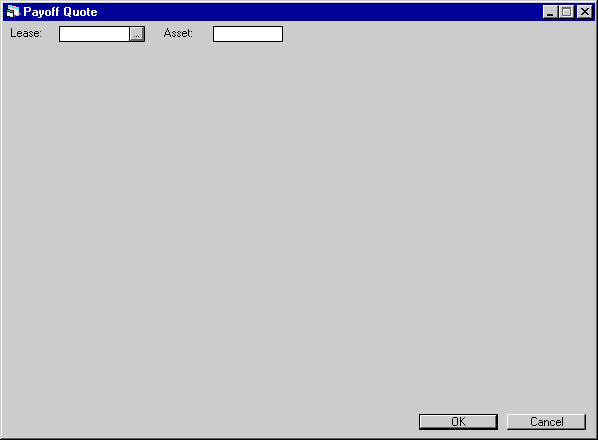
This
screen is used to specify the number of the lease or asset for which to quote.
When a lease or asset
contains a Suspense balance item, a warning message will notify the user of the
suspense balance amount prior to processing the Payoff Quote. This warning message
will not be displayed for batch processes or when a Suspense balance is added
and/or changed via the G/L Adjustments [U0121] update.
- LEASE
Enter the lease number if
a lease level payoff or termination quote is desired. Leave LEASE blank if an
asset number is to be entered.
- ASSET
Enter the asset number if
an asset level payoff or termination quote is desired. An asset payoff or termination
is not allowed if there is only one asset associated with the lease. In this case,
the entire lease must be paid off or terminated.
If the Asset
Percentage Calc Method (A/P) switch in Miscellaneous Customization option of the
Custom General update [U0712] is set to ‘A’, LeasePak will allow for an NPV Payoff
method on an asset with irregular payment schedule and *APR accrual method type.









Quote Type
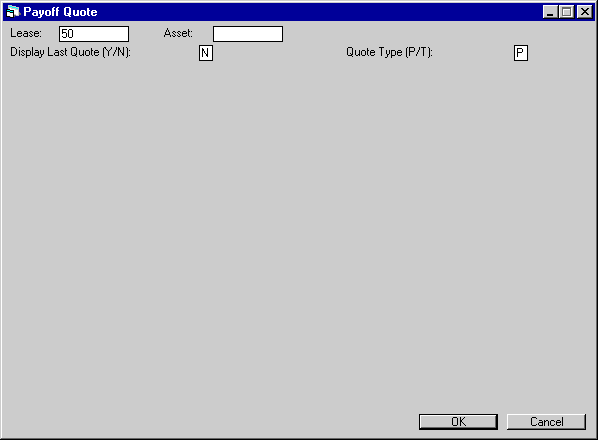
This screen appears once a lease
or asset number is entered. If no current quote is stored for the lease or asset,
then N is defaulted for DISPLAY LAST QUOTE and may not be changed. If a current
quote exists, the QUOTE TYPE (P’ for payoff, or T for termination) is displayed.
- DISPLAY
LAST QUOTE (Y/N)
This
field is informational only and may not be accessed if no current quote is available.
Enter Y to display the current
quote. Enter
N to request a new quote. If N is entered, QUOTE TYPE may be changed from its
defaulted value.
- QUOTE
TYPE (P/T)
This field
may be accessed if N is entered for DISPLAY LAST QUOTE.
Enter
P for a payoff quote or T for a termination quote. For a payoff, the lessee retains
the leased equipment. For a termination, the lessee returns the equipment.









Effective Date, P/T
Method
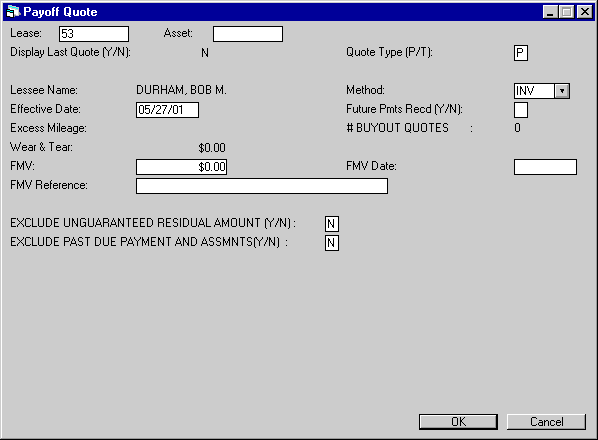
This screen is used to enter information
required for a payoff or termination quote. It is shown if N is entered for
the DISPLAY LAST QUOTE (Y/N) field on the previous screen. The short form of
the lessee name is displayed.
- EFFECTIVE DATE
Enter the effective
date of the payoff in a MM/DD/YY or DD/MM/YY format, depending on the Date
Format Preference field in Security [U0706]. For other than interest bearing
loans the EFFECTIVE DATE is defaulted to the earlier of:
- The current date,
- The accrued to
date of the lease, or
- The maturity date
of the lease.
- For interest bearing
loans EFFECTIVE DATE is defaulted to the later of:
- The last payment
effective date, or
- The accrued to
date of the loan.
EFFECTIVE DATE may be changed
to any date on or after the last payment effective date (it may be after
the lease maturity date). LeasePak automatically "reverses" the
lease back or "accrues" it forward to the EFFECTIVE DATE entered
for purposes of payoff or termination calculation. This means that the lease
is reversed or accrued to the first payment due date on or before the EFFECTIVE
DATE. For example, a lease with a payment due date of the first day of the
month and a payoff with an EFFECTIVE DATE in the past of 11/30, reverses
accruals to 11/1.
Note: Use tax
is calculated based on the current tax payment code and/or location of the
asset(s). Incorrect use tax may be calculated if the location and/or tax
payment code is changed during the period for which accrual reversal is
performed.
- WEAR & TEAR
Enter an amount, if
desired, for termination quotes only.
- EXCESS MILEAGE
Enter, if desired, the
number of miles over the allowable mileage recorded for a vehicle, if applicable.
This number times the cents/mile charge as specified on the lease agreement
is the excess mileage charge for termination quotes only. This field may be
accessed only if the lease agreement contains an excess mileage charge for
terminations (refer to the TERMINATION
INFORMATION screen of the Lease Form update [U0721]). The excess mileage
charge is included in the FEE/PENALTY amount.
- FMV
An amount for the fair
market value must be entered for the RV (realized value) method payoff quote
and all termination quotes.
When an OPER asset is terminated,
a calculated FMV will be displayed on the screen. Changing the FMV to another
amount will not be allowed.
- METHOD
Enter the payoff or
termination method to use for the quote. METHOD defaults to the method on
the Lease Form for the lease and may be changed. Use Help for a list of valid
methods.
LeasePak calculates the income of INV, OPR and PRN type methods based on the
Payoff Customization switches in the
Portfolio [U0212] update.
Refer to the LeasePak Calculations document for information on payoff
and termination methods.
Note: LeasePak allows
the NPV Payoff method for Payoff Quotes on Operating type leases. The Base
Payoff amount calculation will use the NPV discount rate, the reamaing payment
stream and the Residual Value of the asset. The Include
IDC in INV and OPR Payoff field in Payoff Customization [U0212] works
in conjunction with this field.
Payoff Quotes with NPV type method can not be recalled in the Payoff [U0103]
update.
Note: LeasePak
allows the Rule of 12/78th to be used as a payoff method for precomputed,
AAPR/RAPR accrual methods leases only. Additionally, payoff quote effective
date can not be less than the accrued to date.
- FUTURE PMTS RECD (Y/N)
This field may only
be accessed if the EFFECTIVE DATE is after the accrued to date of the lease.
Enter Y if future payments (payments after the accrued to date) are assumed
to be received on their due dates. Enter N if no future payments are assumed
to be received.
- NUMBER OF BUYOUT QUOTES
This field displays
the number of buyouts for a lease quoted to a customer. The number of buyout
quotes for an asset will not be recorded. Both payoff and termination quotes
are considered buyout quotes.
- FMV DATE
A date for the FMV quoted
may be entered for RV (realized value) method payoff and termination quotes
only. This is an informational date.
- FMV REFERENCE
The source of the FMV
quoted (e.g., appraisal, blue book, residual value, etc.) may be entered for
RV (realized value) method payoff and termination quotes only. This is an
informational field.
- EXCLUDE UNGUARANTEED RESIDUAL
AMOUNT (Y/N)
This field appears when
the 1998 JULE Fund module is purchased. This field allows the user to select
Y or N for LeasePak to calculate the unguaranteed residual of the payoff amount.
It is accessible when the payoff method is NPV.
When this field is set to
Y, the unguaranteed residual amount will be excluded in the calculation of
the payoff base amount. Additionally, when the actual BASE
PAYOFF amount in Payoff [U0103] is calculated, LeasePak will include the
unguaranteed residual amount and the user will receive a warning message:
Base Amount differs from Quoted Base Amount. It is assumed that sufficient
funds will be available to cover the actual NPV payoff amount or a different
payoff method/quote will be used.
- EXCLUDE PAST DUE PAYMENT AND
ASSESSMENT (Y/N)
This switch will appear
when the Off
Lease Billing module is purchased. This field will work in conjunction
with the PAYOFF INVOICE
DUE DAYS field in the Miscellaneous Customizations option of the Custom
General [U0712] update.
Enter Y for all past due
payment and assessments to be excluded from the Payoff Quote. This will allow
the user to override the Base Amount and the outstanding payment and/or assessment
amount. Enter N for all past due payments and assessments to be included in
the Payoff Quote.









Sales Tax (Payoff)
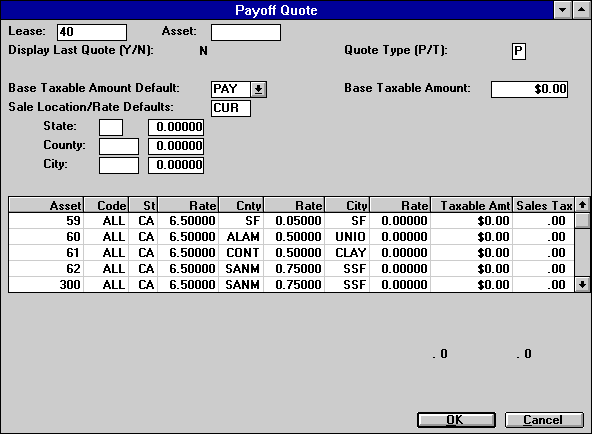
This
screen is used to specify the sales tax requirements for the payoff and, as such,
is only shown for lease or asset payoff quotes. It is not displayed for termination
quotes. This screen is displayed only if sales tax should be charged on the sale,
as determined by the Lease Form code for the lease (refer to the Lease
Form update [U0721]).
Sales tax calculated here appears
in the actual Payoff update [U0103], and may be adjusted by changing the information
through this screen or through its counterpart in the Payoff update.
- BASE
TAXABLE AMOUNT DEFAULT
Enter
the code to indicate the means of determining the base taxable amount for each
asset on the payoff. BASE TAXABLE AMOUNT DEFAULT is PAY for new quotes. If a previous
quote exists, the base taxable amount defaults to that of the last quote, and
may be changed. Blank out this field if no BASE TAXABLE AMOUNT should be defaulted.
Valid codes are: PAY The
asset’s portion of the BASE TAXABLE AMOUNT, determined by the asset’s percentage
in the total lease, is the default TAXABLE AMT for the asset. The BASE TAXABLE
AMOUNT is defaulted to the base payoff amount and may be changed from its defaulted
value if this code is chosen.
RES The
asset’s residual value is the default TAXABLE AMT for the asset. The BASE TAXABLE
AMOUNT is defaulted to the total residual value and may be changed from its default.
Note that this option will place the asset’s residual value in the field TAXABLE
AMT, and the total in the field BASE TAXABLE AMOUNT. A change of the BASE TAXABLE
AMOUNT does not change the TAXABLE AMT for each asset.
FMV The fair market
value of the asset, as entered by the user for each asset, is the taxable amount.
Note that this option will not default a value in the field TAXABLE AMT for each
asset, nor will a BASE TAXABLE AMOUNT be defaulted.
- BASE
TAXABLE AMOUNT
The amount
defaults based on the code entered in Base Taxable Amount Default and may be changed.
If the lease is subject
to value added tax, the Base Taxable Amount is the amount subject to VAT. For
example, when the UPFRONT VALUE ADDED TAX switch is set to Y for the portfolio,
the Base Taxable Amount may be principal only.
- SALE
LOCATION/RATE DEFAULTS
Enter
the code to indicate the sale location and rate to default for each asset on the
payoff, as shown in the scrolled area. The default is CUR for new quotes or LPQ
when displaying the last quote, and may be changed.
This
field may be used as a quick way to enter sale location and rate information for
each of the assets in the scrolled area. Actual sale location and rate for individual
assets may then be changed, if necessary. Therefore, if one of the following methods
approximates the conditions of the sale, use it to default the information and
then change the required pieces of information as needed. Blank out this field
if no locations or rates are to be defaulted. Valid
codes are: CUR The
current state, county, and city locations and use tax rates on file for the assets
should be used as the default sale location and sales tax rates for each asset
in the scrolled area.
A
specific state, county, or city rate can subsequently be automatically changed
using the following default location and rate fields. For example, if the assets
are being sold in their current location, however the applicable state sales tax
rate is different from the defaulted state use tax rate, enter the STATE LOCATION
DEFAULT and the STATE RATE DEFAULT to automatically change the defaulted state
rate for all assets in that state. All other information is unaffected. This process
may be repeated for multiple adjustments to the information in the scrolled area.
NEW The
state, county, and city locations and rates for each asset should all be defaulted
with a single user-specified state, county, and city location and rate. The location
and rate is specified through the default location and rate fields. (Any or all
of the state, county, and city locations and rates may be entered as default information.)
LPQ The
last quote’s state, county, and city locations and sales tax rates for the assets
should be used as the default sale location and sales tax rates for each asset
in the scrolled area. This code is valid only when displaying the last quote.
A
specific state, county, or city rate can subsequently be automatically changed
using the default location and rate fields. For example, if the assets are being
sold in their current location, however the applicable state sales tax rate is
different from the defaulted state use tax rate, enter the STATE LOCATION DEFAULT
and the STATE RATE DEFAULT to automatically change the defaulted state rate for
all assets in that state. All other information is unaffected. This process may
be repeated for multiple adjustments to the information in the scrolled area.
- STATE
LOCATION DEFAULT
Enter
the 2-character post office abbreviation of the state location of the sale. The
state must be a valid state on the Location (DLO) file.
If
the SALE LOCATION/RATE DEFAULTS code is NEW, this field is used in conjunction
with STATE RATE DEFAULT to default all assets in the scrolled area with the state
location and STATE RATE DEFAULT. If the SALE LOCATION/RATE DEFAULTS code is CUR
or LPQ, this field is used in conjunction with STATE RATE DEFAULT to change the
state sales tax rates for all assets located in the state to the specified STATE
RATE DEFAULT.
- STATE
RATE DEFAULT
Enter the
state rate default for the state location default. A value may not be entered
if a STATE LOCATION DEFAULT is not entered.
If
the SALE LOCATION/RATE DEFAULTS code is NEW, all assets in the scrolled area are
defaulted with the state rate entered in this field. If the SALE LOCATION/RATE
DEFAULTS code is CUR or LPQ, this field is used in conjunction with STATE LOCATION
DEFAULT to change the state sales tax rates for all assets located in the specified
state to the rate entered in this field.
- COUNTY
LOCATION DEFAULT
Enter
the code of the county of the sale. The county must be a valid county on the Location
(DLO) file.
If the
SALE LOCATION/RATE DEFAULTS code is NEW, all assets in the scrolled area are defaulted
with the county location of the one entered in this field.
If the SALE
LOCATION/RATE DEFAULTS code is CUR or LPQ, this field is used in conjunction with
COUNTY RATE DEFAULT to change the county sales tax rates for all assets located
in the county to the specified COUNTY RATE DEFAULT.
- COUNTY
RATE DEFAULT
Enter the
county rate default for the county location default. A value may not be entered
if a COUNTY LOCATION DEFAULT is not entered.
If
the SALE LOCATION/RATE DEFAULTS code is NEW, all assets in the scrolled area are
defaulted with the county rate entered in this field. If the SALE LOCATION/RATE
DEFAULTS code is CUR or LPQ, this field is used in conjunction with COUNTY LOCATION
DEFAULT to change the county sales tax rates for all assets located in the specified
county to the rate entered in this field.
- CITY
LOCATION DEFAULT
Enter
the code of the city of the sale. The city must be a valid city on the Location
file.
If the SALE
LOCATION/RATE DEFAULTS code is NEW, all assets in the scrolled area are defaulted
with the city location of the one entered in this field. If the SALE LOCATION/RATE
DEFAULTS code is CUR or LPQ, this field is used in conjunction with CITY RATE
DEFAULT to change the city sales tax rates for all assets located in the city
to the specified CITY RATE DEFAULT.
- CITY
RATE DEFAULT
Enter the
city rate default for the city location default. A value may not be entered if
a CITY LOCATION DEFAULT is not entered.
If
the SALE LOCATION/RATE DEFAULTS code is NEW, all assets in the scrolled area are
defaulted with the city rate entered in this field. If the SALE LOCATION/RATE
DEFAULTS code is CUR or LPQ, this field is used in conjunction with CITY LOCATION
DEFAULT to change the city sales tax rates for all assets located in the specified
city to the rate entered in this field.
- ASSET
(scrolled area)
The
assets number(s) to be sold are displayed and may not be changed.
- CODE
(scrolled area)
The
use tax payment code is displayed and may not be changed.
- ST
(scrolled area)
Enter
or change the 2-character post office abbreviation of the state of the sale.
- ST RATE (scrolled
area)
Enter or change
the state sales tax rate to be used to calculate tax on the sale of this asset.
ST RATE may be zero.
- CNTY
(scrolled area)
Enter
or change the code of the county of the sale. CNTY may not be entered if the state
entered is outside the U.S.
- CNTY
RATE (scrolled area)
Enter
or change the county sales tax rate to be used to calculate the tax on the sale
of this asset. CNTY RATE may be zero. CNTY RATE may not be entered if the state
entered is a Canadian province.
- CITY
(scrolled area)
Enter
or change the code of the city of the sale.
- CITY
RATE (scrolled area)
Enter
or change the city sales tax rate to be used to calculate the tax on the sale
of this asset. CITY RATE may be zero.
- TAXABLE
AMT (scrolled area)
Enter
or change the amount upon which the sales tax calculation should be based. The
total TAXABLE AMT for all assets is displayed at the bottom of the screen. The
total TAXABLE AMT must equal the BASE TAXABLE AMOUNT when all changes have been
completed.
- SALES
TAX (scrolled area)
The
sales tax is displayed. SALES TAX is calculated as follows:
TAXABLE AMT
*
(ST RATE + CNTY RATE + CITY RATE)
The
total SALES TAX for all assets is displayed at the bottom of the screen.









P/T Amounts
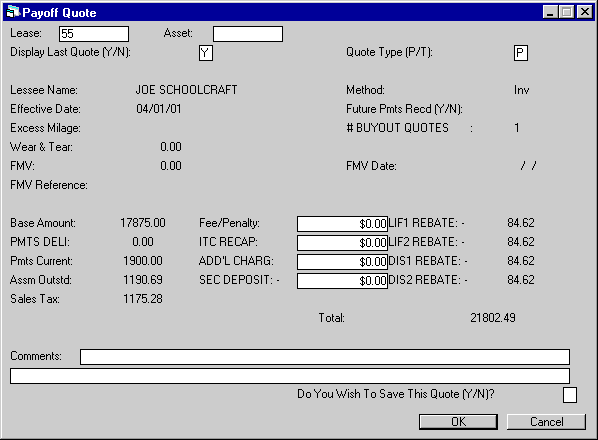
This
screen is used to display the payoff/termination information, as calculated based
upon the parameters entered on the previous screens.
Note:
PER DIEM is displayed if the quote is for an interest bearing loan. INTEREST ADJUSTMENT
is displayed if the quote is for a lease using the WO payoff method.
FEE/PENALTY,
ITC RECAPTURE, and ADD’L CHARGES may be changed to any other value, including
zero. SECURITY DEPOSIT may be reduced to any value between zero and the original
amount. Also, 2 lines of freeform COMMENTS may be entered. The payment amounts
outstanding are broken into 2 categories - delinquent and current. The same calculation
used in the delinquency reports to determine if a payment is delinquent or current
is used here.
If the Purchase Option method for
the lease is PFIX (Calculated Payoff or Fixed Price Purchase) then, if the lease
is matured as of the effective date, the Fixed Price Purchase amount is the
base payoff amount. The message FIXED PRICE PURCHASE OPTION IN EFFECT is automatically
entered as a default comment. This draws attention to the fact that the payoff
calculation requested (INV
in this example) has been overridden by the Fixed Price Purchase Option.
- BASE AMOUNT
The
base amount of the payoff or termination for the lease or asset is displayed and
may not be changed. For interest bearing loans the BASE AMOUNT is the principal
outstanding on the payoff EFFECTIVE DATE.
- PMTS
DELINQUENT
The amount
of the outstanding delinquent payments for the lease or asset is displayed and
may not be changed. For interest bearing loans PMTS DELINQUENT is the amount of
interest accrued on the Invoice (DAR) file (regardless of the invoice due date).
- PMTS CURRENT
The amount of the outstanding
current payments for the lease or asset is displayed and may not be changed. For
interest bearing loans PMTS CURRENT is the amount of interest accrued for the
period between the accrued to date and the EFFECTIVE DATE. PMTS CURRENT will only
have a value if FUTURE PMTS RECD is N.
- ASSM
OUTSTD
The amount of
the outstanding assessments for the lease or asset is displayed and may not be
changed.
- INTEREST
ADJUSTMENT
If METHOD
is WO, the amount of the interest adjustment for the lease or asset is displayed
and may not be changed. Refer to the LeasePak Calculations document for
more information on the WO
payoff method. This field is only displayed if the quote is for a lease using
the WO method.
- SALES
TAX
The amount of sales
tax on the payoff or termination is displayed and may not be changed.
If the lease is subject to value
added tax, VAT on the Base Taxable Amount, Additional Interest and Fee/Penalty
is displayed.
- PER
DIEM
The additional
interest charge for each day after the quote effective date is displayed and may
not be changed. This field appears only if the quote is for an interest bearing
loan.
- FEE/PENALTY
The amount of any outstanding
fees or penalties for the lease or asset is displayed. When displaying the last
quote, the last quoted FEE/PENALTY amount is displayed. This may be changed to
any other amount.
- ITC
RECAPTURE
The amount
of Investment Tax Credit to recapture (for payoff quotes) is displayed. When displaying
the last quote, the last quoted ITC RECAPTURE amount is displayed. This may be
changed to any other amount.
- ADD’L
CHARGES
The amount of
any additional charges for the lease or asset is displayed. When displaying the
last quote, the last quoted ADD’L CHARGES amount is displayed. This may be changed
to any other amount.
- SECURITY
DEPOSIT
The existing
security deposit associated with the lease is displayed and may be changed. When
displaying the last quote, the last quoted FEE/PENALTY amount is displayed. The
amount may be changed to any amount between zero and the security deposit on file.
TOTAL is reduced by the security deposit amount.
- LIF
1 REBATE
The total IDR7
- Credit Life Insurance 1/Rebate amount for the lease is displayed, when the Vehicle
Finance module is purchased.
- LIF
2 REBATE
The total IDR8
- Credit Life Insurance 2/Rebate amount for the lease is displayed, when the Vehicle
Finance module is purchased.
- DIS
1 REBATE
The total IDR9
- Credit Disability 1/Rebate amount for the lease is displayed, when the Vehicle
Finance module is purchased.
- DIS
2 REBATE
The total IDRA
- Credit Disability Insurance 2/Rebate amount for the lease is displayed, when
the Vehicle Finance module is purchased.
Note:
The Rebate amount of the Credit Life Insurance 1/2, Credit Disability 1/2 may
be used to reduce the payoff amount. The additional G/L accounts added calculate
the difference between the rebate amount and the existing unearned amount.
If the Insurance Unearned is to zero because of the canceled insurance, than the
rebate amount must be zero in the Rebate screen of the Lease Form Code update
[U0721].
- TOTAL
The total payoff amount
is displayed.
- COMMENTS
Enter, if desired, any comments
in connection with the quote.
- DO
YOU WISH TO SAVE THIS QUOTE (Y/N)
If
Y is entered, all the information on this screen is saved and the buyout quote
counter will be incremented by one. Additionally, the user’s initials and the
date/time of the quote are saved. Previous quote information is overwritten. If
N is entered, the quote is not saved and no changes are made to quote information
already stored on file (if any).









Create Audit Report
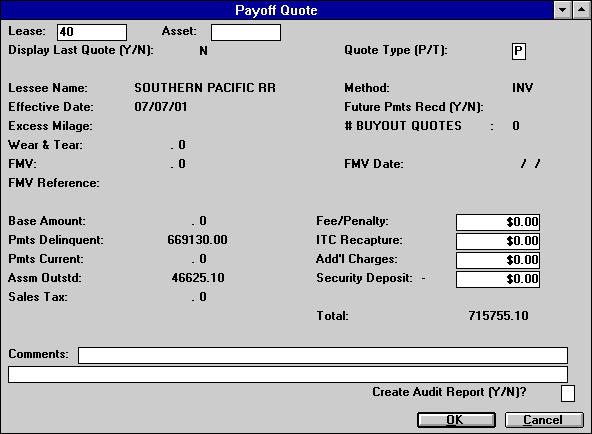
This screen allows the user to create
an audit report of the payoff or termination quote that is displayed.
- CREATE
AUDIT REPORT (Y/N)
If
Y is entered, the audit report is generated when RETURN is pressed. If an audit
report is created, it is directed to the printer selected by the user at the start
of the Payoff Quote update [U0213].









Payoff Quote Audit

The Payoff Quote Audit report [U0213A] reports at the lease or asset level and
provides the following payoff quote information for each lease or asset quoted:
The
TAX RATE is established on the second screen of the Miscellaneous Customizations
option of the Portfolio update [U0212].
- INTEREST
ADJ
This information
is only displayed if the payoff method is WO. Refer to the LeasePak Calculations
document for details on interest adjustment calculation under the WO
method.
- WRITE
OFF CALC
This information
is displayed if the payoff method is WO and the quote is for a termination.
- FIX PRICE PURCH
OPT
The amount of the
fixed price purchase option is displayed.
- PER
DIEM
The additional
interest charge for each day after the quote effective date is displayed, if the
quote is for an interest bearing loan.
- MATURITY
DATE
The maturity date
of the lease is displayed.
- PROJECTION
RATE
The base rate used
for a projected quote’s interest calculations is displayed, if the quote is for
an interest bearing loan.
- GROSS
RECEIVABLE BALANCE
The
gross receivable balance, as defined through the Calculation Customizations option
of the Portfolio update [U0212], is displayed.
- NET
OUTSTANDING BALANCE
The
net outstanding balance, as defined through the Calculation Customizations option
of the Portfolio update [U0212], is displayed.
- GROSS
OUTSTANDING BALANCE
The
gross outstanding balance, as defined through the Calculation Customizations option
of the Portfolio update [U0212], is displayed.
©
2001 by McCue Systems Incorporated.
All rights reserved.
The
information contained in this document is the property of McCue Systems, Inc.
Use of the information contained herein is restricted. Conditions of use are subject
to change without notice. McCue Systems, Inc. assumes no liability for any inaccuracy
that may appear in this document; the contents of this document do not constitute
a promise or warranty. The
software described in this document is furnished under license and may be used
or copied only in accordance with the terms of said license. Unauthorized
use, alteration, or reproduction of this document without the written consent
of McCue Systems, Inc. is prohibited.









